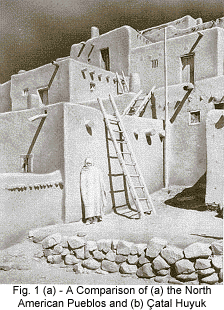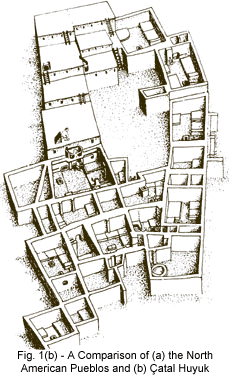The archetype of the Earth Diver is Vishnu, in his Boar avatar (Varaha). The one of the Fallen Sun is, again, derived from a Hindu archetype; that of Vishvasvat, the Sun, and his many aliases. Both of these Cosmogonic motifs date from Vedic times in India, and there can be no question of Hindu precedence.
As we said above, the Navajos learnt their Mystery Religion from Pueblo Indians such as the Zuņi of New Mexico. The Zuņi in turn relate to the Aztecs and the Mayas of Mexico, whose advanced civilization is well-known. This diffusion of civilization can be traced further back to the Incas of Peru and, across the Pacific Ocean, all the way to Indonesia and to India.
The Pueblos and the Architecture of Įatal Huyuk
It is sufficient to compare the unique pueblo constructions of the Pueblo Indians with those of Įatal Huyuk, in Anatolia, or those of Harappa and Mohenjo-daro, to conclude that they were undoubtedly built (or designed) by the one and same people (see Fig.1 below). The pueblos are, like their Old World counterparts, a sort of human "beehive" in which the individual apartments form "cells" destitute of doors and windows.
The only access is through the roof, by means of a manhole and ladder. In case of attack, the ladders could be withdrawn, and the "city" became an impregnable fortress. Įatal Huyuk has been dated at 9,000 years ago, and is one of the oldest known cities. Burial methods, the advanced agriculture, bull-worship and the cult of the Great Mother, and several other similarities further testify to an ancient connection among these distant sites.
Indeed, the sun-dried mud bricks fired when firewood was available lead us to think of Adam, made of the same stuff. Zuņi mythology depicts their ancestors actually emerging from the underground mud in Paradise and immigrating to their present location.

Atlantis, Eden and the Seven Golden Cities of Cibola
The Pueblos were early associated by the Spaniards with the Seven Golden Cities of Cibola and with the legend of the Eldorado. And these are, as we argue elsewhere, the same as the Seven Islands of the Blest, which are no other than the sunken Eden of the Judeo-Christians. The name of the Golden Cities of Cibola very obviously came from the Dravida civ-pola, meaning "golden city" or, yet, "city of the reds". It is interesting to note that "Reds" or "Golden" are usual epithets of the Atlanteans. Adam too was a "Red", that is, a Chamite, as his name (means "red") unequivocally indicates.
Moreover, the number seven attached to the cities of Cibola is also the one of the Isles of the Blest and similar sunken realms of the ancients. In fact, the number alludes to the seven great islands of Indonesia: Java, Sumatra, Borneo, Celebes, Philippines, New Guinea and the Malay Peninsula, which the ancients counted as an island.
We recall that the fundamental rule of the science of symbolism is that a symbol or a convention cannot be invoked to explain the origin of another symbol, for this just transfers the problem. So, the sacredness of the number seven the holiest number of the Hindus can only derive from their seven Dvipas or Paradises, that is, from precisely the above islands. Can you think of another sacred seven that is not purely conventional in origin?
The Spaniards mistook the Americas which they later called West Indies for the East Indies, which they knew to be the site of Paradise and, hence, of the fabled Seven Golden Cities of Cibola. Cibola, "the Golden City", is just one of the many names of Lemurian Atlantis. The name of "Seven Golden Cities" or "Seven Golden Islands" was applied by the ancients to the Indonesian islands, and to no other place. This name is indeed a translation of the Sanskrit Suvarna-dvipa, which gave the Greek Chryse Chersonesos and the Latin Aurea Chersonesus, all meaning the same thing as "Golden City" or "Golden Island".

The Twins and the Great Mother
The Navajos trace descent through the mother, and their families centers around the grandmother. This is another evidence of their cult of the Great Mother, which is a feature of Dravidian Hinduism. The Navajo rites, chants and dances are based entirely on the characters, incidents and places of their mythology and ritual designs. The dancers wear masks and dresses according to exacting standards, and impersonate the gods and heroes (Kachina) of their mythology.
Foremost among these ancestral heroes of the Navajos are the Twins, the sons of Sun and Earth-Mother. These Twins are also called "Little War-Gods", a name which closely evokes that of the Hindu Ashvin Twins and, more exactly, the two brothers Skanda and Ganesha, respectively the generalissimos of the gods and of the devils in Hindu mythology.
The Twins free the earth from all sorts of monsters, creating order out of the prevalent chaos.